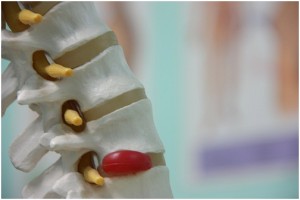Artificial Disc Replacement surgery is the most effective treatment for cases where patients suffer from Severe Degenerative Disc Disease.
The Need for Artificial Disc Replacement
The disc is the portion of the vertebrae that acts as cushioning between the various bones of the spine. It is composed of cartilage and tissue, with a soft center called a nucleus and an outer covering called annulus. These discs act as shock absorbers in the spine and protect the vertebral bones against damage from any trauma, strain or injury.
They absorb the shock of falls, allow flexibility in turning and bending, and absorb some of the pressure placed on the vertebrae when any strenuous activity like lifting weights is followed. But, as the years go by, these discs might lose their flexibility and cushioning. They may dry up, become distended, get pushed out, tear or split.
While in most cases this normal wear and tear does not really affect the functioning of the body in any perceptible way, some conditions, through natural degeneration or through injury, may cause chronic pain and discomfort.

Treatments for Degenerative Disc Disease
Most degenerative disc disorders don’t need surgical intervention. Some might be simple issues that a few days rest and a few strengthening exercises can cure. Other disorders might need frequent application of hot or cold packs, and some might need physical therapy, while more severe cases might need surgical interference.
-
Artificial Disc Replacement Surgery
Artificial Disc Surgery is a relatively new surgical procedure that has emerged as a treatment for injured or damaged discs. In this procedure, part or the whole of a disc might be removed and replaced with an artificial disc made of plastic or metal, or a combination of both. The patient has to be under anesthesia during surgery.
-
Cervical Disc Replacement Surgery
Cervical Disc Replacement Surgery involves replacing a damaged disc in the neck. In this procedure, the damaged disc is removed, and the bones above and below this disc are separated to the correct distance, in a way that they would be apart if a normal undamaged disc were present between them. Then the artificial disc is inserted into this space. The patient can go home within a day or two of this procedure.
-
Lumbar Disc Replacement Surgery
Lumbar disc replacement or back disc replacement surgery is the replacement of an affected disc in the lower vertebrae. Lumbar disc replacement technology has been used for long in Europe and there are several different procedures. The disc replacement can be partial or full. The hospital stay for lumbar disc replacement surgery is two to four days.
The Disc Replacement Surgery Procedure
Generally, partial disc replacement surgery involves the replacement of the soft center of the disc known as the nucleus. In full disc replacement, both the nucleus and the annulus are replaced.
Full Disc Replacement Surgery
The general method for full disc replacement is to use two plates and a soft central piece to replace the damaged disc. The two plates are attached to the bones above and below the disc being replaced. The soft center is then inserted between these pieces, and these generally curved surfaces then facilitate movement by sliding across each other.
Partial Disc Replacement Surgery
Nucleus replacement procedures generally use soft plastic type of materials. One, called Hydrogel, expands on absorbing water. When placed into the nuclear cavity, this device expands and fills the cavity. Another design is to use a plastic-like coil to fill the cavity.
Artificial Disc Replacement Surgery, though newer than the conventional fusion process, is more effective and allows patients more natural functioning after the surgery. It provides quicker and long term relief, if all the pre disc replacement and post operative disc surgery recovery procedures are followed correctly.